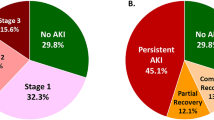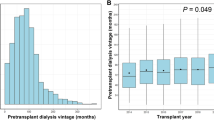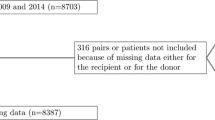Abstract
Acute renal failure (ARF) is common immediately after orthotopic liver transplantation (OLT), whereas the incidences of chronic kidney disease (CKD) and end-stage renal disease increase with time. Introduction of the Model for End-stage Liver Disease (MELD) score—intended to prioritize patients with more-severe pretransplantation liver disease in general, and worse pretransplantation renal function in particular—for the allocation of liver grafts led to concerns about compromised patient and allograft survival and increased incidence of postoperative ARF and CKD. Nonetheless, it has been suggested that early OLT of candidates with baseline renal dysfunction improves post-transplantation renal outcomes. For OLT candidates with mild to moderate chronic renal impairment or recent-onset ARF, the decision of whether to perform OLT alone or combined liver–kidney transplantation (CLKT) can be challenging because no single factor has been shown to be predictive of the degree of renal function recovery or CKD progression following successful OLT. In this article, we provide an overview of the literature on renal function outcomes following OLT and CLKT, share our perspectives on the potential predictors of renal dysfunction or nonrecovery of renal function after OLT, and present United Network for Organ Sharing data on patient and allograft outcomes in CLKT recipients in the pre-MELD and post-MELD eras. Mechanisms that might underlie immunological protection of kidney grafts by liver allografts are also discussed.
Key Points
-
Studies of renal function after orthotopic liver transplantation (OLT) have yielded conflicting results, and there is a paucity of data on renal outcomes after combined liver–kidney transplantation (CLKT)
-
The Model for End-stage Liver Disease (MELD) score, introduced in February 2002 for allocation of organs available for OLT, prioritizes patients with more-severe pretransplantation liver disease in general, and worse pretransplantation renal function in particular
-
More CLKTs have been performed, in both absolute and relative terms, since the introduction of the MELD score
-
Evidence indicates that liver allografts have an immunoprotective effect on kidney allografts from the same donor when the organs are transplanted together
This is a preview of subscription content, access via your institution
Access options
Subscribe to this journal
Receive 12 print issues and online access
$209.00 per year
only $17.42 per issue
Buy this article
- Purchase on Springer Link
- Instant access to full article PDF
Prices may be subject to local taxes which are calculated during checkout



Similar content being viewed by others
References
Gonwa TA et al. (2006) Continued influence of preoperative renal function on outcome of orthotopic liver transplant (OLTX) in the US: where will MELD lead us? Am J Transplant 6: 2651–2659
Pawarode A et al. (2003) Independent risk factors and natural history of renal dysfunction in liver transplant recipients. Liver Transpl 9: 741–747
Cohen AJ et al. (2002) Chronic renal dysfunction late after liver transplantation. Liver Transpl 8: 916–921
Campbell MS et al. (2005) Renal function after orthotopic liver transplantation is predicted by duration of pretransplantation creatinine elevation. Liver Transpl 11: 1048–1055
Marik PE et al. (2006) The course of type 1 hepatorenal syndrome post liver transplantation. Nephrol Dial Transplant 21: 478–482
Pham PT et al. (2007) The impact of pre-transplant renal dysfunction on renal function outcomes after orthotopic liver transplant [abstract]. Presented at the World Congress of Nephrology: 2007 April 21–25, Rio de Janeiro, Brazil
Machicao VI et al. (2006) Impact of implementation of the MELD scoring system on the prevalence and incidence of chronic renal disease following liver transplantation. Liver Transpl 12: 754–761
Davis C (2006) Impact of implementation of the MELD scoring system on the prevalence and incidence of chronic renal disease following liver transplantation. Liver Transpl 12: 707–709
Cabazuelo JB et al. (2004) Risk factors of acute renal failure after liver transplantation. Kidney Int 69: 1073–1080
Alessandria C et al. (2005) MELD score and clinical type predict prognosis in hepatorenal syndrome: relevance to liver transplantation. Hepatology 41: 1282–1289
Pham PT et al. (2005) Review article: current management of renal dysfunction in the cirrhotic patient. Aliment Pharmacol Ther 21: 949–961
Pham PT et al. Kidney dysfunction in the recipients of liver transplants. In Critical Care Nephrology (Eds Kellum JA and Ronco C) London: Elsevier (in press)
Davis C (2005) Impact of pretransplant renal failure: when is listing for kidney-liver indicated? Liver Transpl 11 (Suppl 1): S35–S44
Gonwa T (2005) Combined kidney liver transplant in the MELD era: where are we going? Liver Transpl 11: 1022–1025
Pham PT et al. (2005) Renal failure in the adult renal transplant recipients. In Transplantation of the Liver, edn 2 891–916 (Eds Busuttil RW and Klintmam B) Philadelphia: Elsevier Saunders
Ueno T et al. (2006) Liver and kidney transplantation for polycystic liver and kidney: renal function and outcome. Transplantation 82: 501–507
United Network for Organ Sharing. Combined liver-kidney transplants performed between 1995–2004. [http://www.unos.org/helpSaveALife/] (accessed 22 June 2007)
Rasmussen A et al. (1995) Combined transplantation of liver and kidney from the same donor protects the kidney from rejection and improves kidney graft survival. Transplantation 59: 919–921
Eid A et al. (1990) Evidence that the liver does not always protect the kidney from hyperacute rejection in combined liver and kidney transplantation across a positive lymphocyte crossmatch. Transplantation 50: 331–334.
Katznelson S and Cecka JM (1996) The liver neither protects the kidney from rejection nor improves kidney graft survival after combined liver kidney transplantation from the same donor. Transplantation 61: 1403–1405
Mjörnstedt L et al. (1997) Combined liver and kidney transplantation against a positive cross match in a patient with multispecific HLA-antibodies. Transplant Proc 29: 3164–3165
Morrisey PE et al. (1998) Combined liver-kidney transplantation in patients with cirrhosis and renal failure: effect of a positive crossmatch and benefits of combined transplantation. Liver Transpl Surg 4: 363–369
Pollack MS (2003) The very rapid loss of donor specific antibodies from the circulation after liver transplantation allows successful kidney transplantation from the same donor for even the most highly sensitized patients [abstract]. Hum Immunol 64 (Suppl 1): S62
Gutierrez A et al. (2003) Outcomes of simultaneous liver-kidney transplantation in highly sensitized, cross-match positive patients. Transplant Proc 35: 1861–1862
Gugenheim J et al. (1990) Specific absorption of lymphocytotoxic alloantibodies by the liver in inbred rats. Transplantation 50: 309–313
Simpson N et al. (2006) Comparison of renal allograft outcomes in combined liver-kidney transplantation versus subsequent kidney transplantation in liver transplant recipients: analysis of UNOS database. Transplantation 82: 1298–1303
Olausson M et al. (2007) Successful combined partial auxiliary liver and kidney transplantation in highly sensitized cross-match positive recipients. Am J Transplant 7: 130–136
Acknowledgements
We are indebted to Ms Katarina Anderson for providing the OPTN/UNOS data. This work was supported in part by Health Resources and Services Administration contract 234-2005-370011C. The content is the responsibility of the authors alone and does not necessarily reflect the views or policies of the Department of Health and Human services, nor does mention of trade names, commercial products, or organizations imply endorsement by the US Government.
Author information
Authors and Affiliations
Corresponding author
Ethics declarations
Competing interests
The authors declare no competing financial interests.
Rights and permissions
About this article
Cite this article
Pham, PT., Pham, PC. & Wilkinson, A. Renal function outcomes following liver transplantation and combined liver–kidney transplantation. Nat Rev Nephrol 3, 507–514 (2007). https://doi.org/10.1038/ncpneph0574
Received:
Accepted:
Issue Date:
DOI: https://doi.org/10.1038/ncpneph0574
This article is cited by
-
Predictors of renal recovery in patients with pre-orthotopic liver transplant (OLT) renal dysfunction
BMC Nephrology (2013)
-
Pre-transplant Kidney Function Predicts Chronic Kidney Disease After Liver Transplant: Meta-Analysis of Observational Studies
Digestive Diseases and Sciences (2011)
-
Cystatin C level as a marker of renal function in allogeneic hematopoietic stem cell transplantation
International Journal of Hematology (2010)



